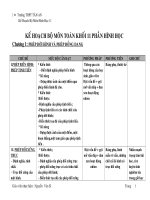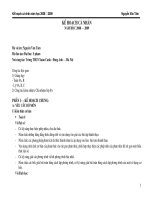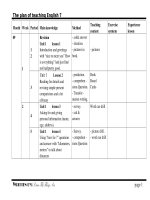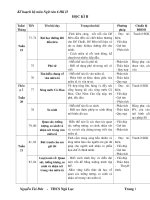SỔ kế hoạch bộ môn 6
Bạn đang xem bản rút gọn của tài liệu. Xem và tải ngay bản đầy đủ của tài liệu tại đây (59.73 KB, 13 trang )
Chương
Tuần
Tiết
Tên bài dạy
Mục đích yêu
cầu của chương
Kiến thức trọng tâm TB,
ĐDDH
Phương
pháp
1
2
1
1
2
3
4
1
2
6
7
Giới thiệu BM
và hướng dẫn
cách học
Unit 1
Greeting
Unit 2
At school
- show Ss how
to study
English well
- Greet people
- Identify
oneself
- Ask how
people are
- Say goodbye
- Introduce
oneself and
others
- Say how old
one/others
is/are.
- Count to 20
- Give and
obey orders
- Ask for and
The ways how to study English effectively
- Hello/ Hi. "I'm.../ My name...." to introduce
yourself.
- How are you? I'm fine, thanks. To greet each
other.
- "Good morning/ afternoon/ evening" to greet
each other. "We're...." to talk about age and
contrast with us.
- "How old are you? " to talk about age...
- Further practice in numbers from 1 to 20 to
count and give telephone numbers.
- Classroom, imperative to understand the
teacher's commands
-"Where do you live? question & answer you
Text-books
- Text book
- Pictures
- Poster
- Cassette
- Tape
- Text
book
- Pictures
- Teacher
<-> whole
class
- Teacher
<-> whole
class
- Group
work
- Pair work
Individual
- Teacher
<-> whole
class
3 4
5
6
11
12
16
Unit 3
At home
give personal
information
- Identify
oneself and
others
- Identify
places, people
and objects.
- Identify
places and
objects
- Give personal
information
- Identify
people
- Ask for and
give numbers
- Describe the
family
live.
- "What's your name?" and "How do you spell
it?" with the Alphabet to talk about your name.
- Further practice in personal information,
alphabet and numbers.
- This/ that, positive statements and "Yes/no"
questions to talk about people and things at
school.
- "What's this/that?- It's a/an...."to talk about
things in the classroom.
- "Wh" questions with this/ that/ these/ those and
livingroom vocabulary to talk about things in the
house.
- Family vocabulary, possessive pronouns
"my/your/her/his" and "Who's this/that "questions
to talk about family members
- Numbers from 21 to 100 and pronunciation of
plural nouns to count things in the classroom.
- How many .....are there? question and further
practice in numbers to talk about things in the
classroom, livingroom, family
- Poster
- Cassette
- Tape
- Text book
- Pictures
- Poster
- Cassette
- Tape
- Group
work
- Pair work
Individual
- Teacher
<-> whole
class
- Group
work
- Pair work
Individual
4
6
6
7
8
17
18
19
24
.
Grammar
practice 1
KT 1 tieát
Unit 4
Big or small
-consolidate
grammar points
Ss have studied
- Describe
location and
size of school
- Describe
location of
objects
- Identify
possession
- Spell words
- Describe
everyday
activities
- Ask for and
say the time.
- Reading a text about a family to understand the
details and talk about job.
- Further practice in "be" imperatives numbers,
question words, there is there are and furniture
vocabulary.
- Reading a description of a school with practice
in possessive "s" to talk about possessives
- Reading a text about school to understand
details and get further practice in numbers and
school vocabulary.
- Listening to a dialogue about school to
understand details practicing cardinal/ ordinal
numbers and "Which" question to talk about
school.
- Simple present tense, possitive statements with
'he/she' to talk about habitual actions
- Telling the time.
- Text book
- Pictures
- Poster
- Cassette
- Tape
- Teacher
<-> whole
class
- Group
work
- Pair work
Individual
5
6
9
9
10
11
12
25
26
30
31
32
36
Chöûa baøi KT
Unit 5
Things I do
Grammar
practice 2
Unit 6
Places
- Describe
everyday
routines.
- Ask for and
say the time
- Describe
school
timetable
-consolidate
grammar points
Ss have studied
- Give personal
details
- Describe
places
- Describe
locations
- Describe
- Simple present tense with subjects and
"wh"questions and "yes/no"questions to talk
about the daily routines.
- Reading a picture story about Ba's daily
routines to practice present simple tense
- School subject vocabulary with '"have/don't
have/has/doesn't have" to talk about the school
time table
- Further practice in simple present tense, telling
the time, adj with "be" question words. School
subject and day of the week
- Reading a text about where they live to
understand the details and practice vocabulary.
- Town and country vocabulary for describing
places where we live
- Reading a text about where Minh lives to
understand town vocabulary and prepositions of
place.
- Text book
- Pictures
- Poster
- Cassette
- Tape
- Text book
- Pictures
- Poster
- Cassette
- Tape
- Teacher
<-> whole
class
- Group
work
- Pair work
Individual
- Teacher
<-> whole
class
- Group
work
- Pair work
Individual
7
13
13
14
15
37
38
42
43
KT 1 tieát
Unit 7
Your house
Traû baøi KT 1
surroundings
- Describe
objects
- Match
descriptions
with objects.
- Identify
places and
their layouts
- Describe
everyday
actions
- Talk about
habitual actions
- More prepositions of place to describe the
house
- "Where is/are...?"question and answer with
town vocab and prepositions of place to describe
a street.
- Listening to a dialogue and reading a letter
about a house to understand the details.
- Facilities vocabulary with "Is/ are there any...?"
to describe the town.
- Reading a text about Ba's and Chi's houses to
understand the differences between town and
country.
- Integrated skills practice to describe where we
live.
- Simple present tense to talk about
transportation.
- Reading a text about Hoang's daily routines for
further practice in simple present habitual
actions.
- Text book
- Pictures
- Poster
- Cassette
- Tape
- Teacher
<-> whole
class
- Group
work
- Pair work
Individual









